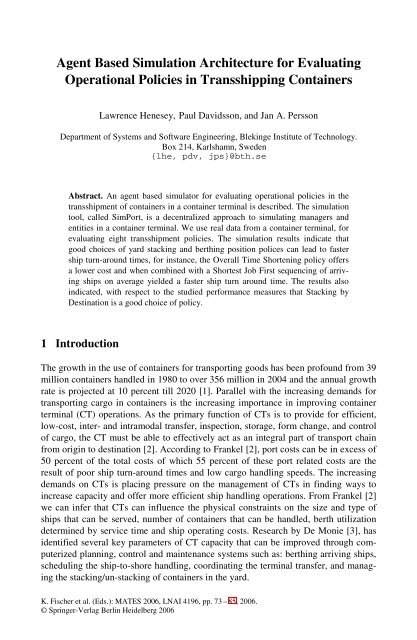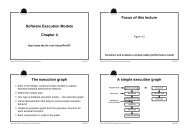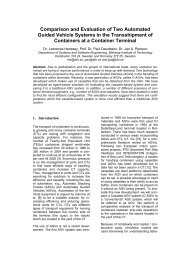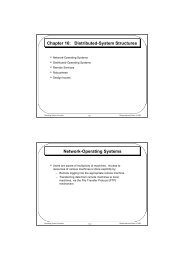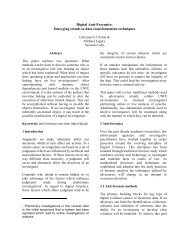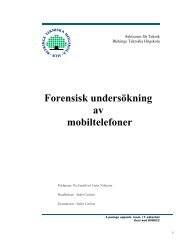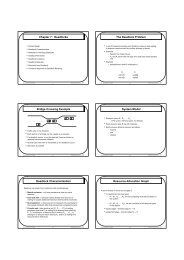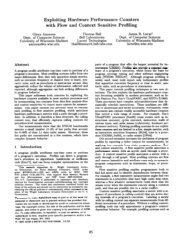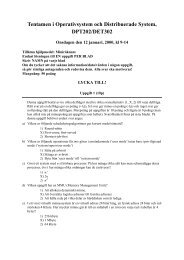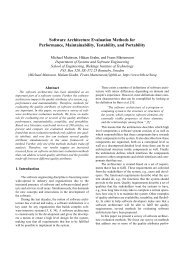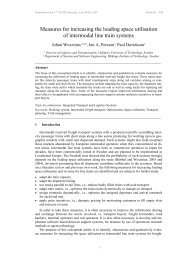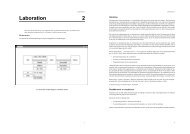Agent Based Simulation Architecture for Evaluating ... - ResearchGate
Agent Based Simulation Architecture for Evaluating ... - ResearchGate
Agent Based Simulation Architecture for Evaluating ... - ResearchGate
- No tags were found...
Create successful ePaper yourself
Turn your PDF publications into a flip-book with our unique Google optimized e-Paper software.
<strong>Agent</strong> <strong>Based</strong> <strong>Simulation</strong> <strong>Architecture</strong> <strong>for</strong> <strong>Evaluating</strong> Operational Policies 75Ship Arrival - The arrival of a ship requires CT management to locate a berth positionso that it can moor along the quay and a service time to schedule operations.This decision on choice of a berth policy has an impact on other decisions in the shipoperations. The berth ‘policy’ is often <strong>for</strong>mulated from choosing a sequence policyand a positioning policy. Basic questions are when and where to place an arrivingship.Loading and Unloading - The loading and unloading sub-processes requiresoperational decisions by the CT management in allocating Quay Cranes (QC) andtransport equipment such as Straddle Carriers (SC) or trucks and labor. Usually, theallocation of these resources is conducted in parallel with the ship arrival process. Thecontainer stowage planning in a ship is a rather complex problem to solve and hasrecently been studied by Wilson and Roach [19], to take as much as 1x10 27 years tooptimally load a 3,000 TEU. Obviously, we need quicker solutions <strong>for</strong> loading andunloading a container ship.Horizontal Transport - An objective that many CT managers share is trying tokeep the assigned QCs from being idle or avoiding interruption during operations soas to quickly service a ship. The availability, allocation and efficient use of terminaltransport are very important to ensure that the QCs are productive. In [20] mentionsthat many CT managers view the interface between the QCs and the yard to be aproblem. Some problems in the horizontal transport process are: load sequence, routing,pickup sequencing and coordination with QCs.Yard Stack / Stack on Quay - Containers are usually sorted using a stacking policywhich may consider, <strong>for</strong> example; type (export or import), and size (i.e. 40’ footor 20’ foot), destination, or by ship line that owns the container, etc. Ideally, in transshipmentoperations the ship that is unloading the containers to be loaded by anothership will be serviced at the same time with the other ship in order to avoid problemsof stacking containers. This scenario offers a faster service. However, in reality thecontainers must often ‘dwell’ or be placed in a yard stack <strong>for</strong> a period of time whilewaiting to be loaded onto another arriving ship. Some problems or decisions affectingthis process are: stacking density; yard stack configuration; container allocation to astack according to rules of “polices”; and dwell times.3 Research Questions and MethodologyIn this paper, we pose the following research question; “how could simulation beused to study the impact of the different policies <strong>for</strong> sequencing of arriving ships, berthingpolicies, and container stacking on the per<strong>for</strong>mance of transshipment operationsat a CT?”The research question stemmed from discussions with CT managers and the resultsfrom the reviewed literature [7]. There often appeared to be a gap in understandingthe complexity of the decisions by the CT managers in the management of a CT, suchas berth assignment, from both theoretical perspectives and from industry practice.Often mentioned, is that existing tools are too cumbersome, do not accurately modelthe CT, are too expensive and not fast. In addition, some CT experts confided thatberth allocation was conducted mostly by middle managers, who did not possessenough in<strong>for</strong>mation in making the berth assignment decision.
80 L. Henesey, P. Davidsson, and J.A. Persson<strong>for</strong> all arriving ships in a scheduled period of time. In determining the berth position<strong>for</strong> an arriving ship the OTS policy is considering the Waiting Time during the simulationfrom a potential set of berth points. The number of possible berth points dependson the berth spacing as well as a ship’s length plus a buffer distance. The shipWaiting Time includes time left in serving another ship that is occupying a part of thequay. The estimation of the Service Time is based on the number of SCs employed,the routes covered by SCs and their average speed. The estimated sums of all theroutes traveled by each SC are totaled to provide the distance being covered by theSCs <strong>for</strong> each ship. From the sum of the estimated Service Time and Waiting Time, i.e.the turn-around time of the OTS policy will place a ship wherever the shortest estimatedship turn-around-time is achieved.Quay Crane (QC) agents are coordinated by a stevedore agent during operations.It receives a list from the stevedore agent which states all containers that should beunloaded/loaded from/to each bay. <strong>Based</strong> on this list, the Crane agent will react bycalling its assigned SC agents and based on their replies, select the SC agent mostappropriate to pick up a particular container based on a) availability (idle/busy) and b)the distance between the SC and the container. The general objective <strong>for</strong> the craneagents is to load/unload containers as fast as possible and use the SCs to move thecontainers to and from the stacks in the most efficient way possible.Straddle Carrier (SC) agents are reacting to requests from their assigned Craneagent; an assumption based upon observations of real CTs where a number of transporterstypically are ‘bounded’ to a specific crane. The SC agents have a map of theCT and their goal is just to satisfy the request of its crane agent. SC agents will sendtheir state to the Crane agent. For example, if the stack that the SC has been assignedto place a container in is full, the SC will go to the closest available stack. The SCmove along one-way paths <strong>for</strong> safety reasons. The SC agents calculate the distancefrom the top left corner of a stack to the position of the crane working a ship’s baylocated at the berth point along the quay. Distance of the stacks may have an influenceon the handling rate of the QCs working a ship.A SC agent determines its next destination through communication with the craneagent. The SC moves to a position in the yard that is generated by communicationwith the crane agent and subsequently establishes its next position by communicatingback to crane agents that it has reached its assigned destination and is waiting <strong>for</strong>another task. The SC agent’s function is to provide specific yard destinations ratherthan the container processing sequence. The model contains rules which determine anappropriate yard location based on current status of the stacks and stacking policy,and attributes of the SC agent.5 Initial ExperimentA real CT was having problems in serving arriving ships leading to ship waiting timeson average three days. The SimPort model was used to evaluate revised stackingconfigurations <strong>for</strong> the yard and the transshipment operational policies.
<strong>Agent</strong> <strong>Based</strong> <strong>Simulation</strong> <strong>Architecture</strong> <strong>for</strong> <strong>Evaluating</strong> Operational Policies 815.1 Experiment SetupThe managers at the CT provided data and layouts of their terminal <strong>for</strong> analysis. Thefollowing entities of the CT terminal were modeled in SimPort:• Terminal: Length and width (meters), e.g., 900 m x 1000 m; Operating hours, e.g.,07:00 – 20:00 from Monday to Friday; The terminal handling charge (THC), a costpaid by the ship lines <strong>for</strong> handling each container unit (100 dollars per container);A “penalty” cost, an extra cost <strong>for</strong> handling containers out of operating hours (150dollars per container); A yard; and A quay.• Yard Stacks: Length of the Yard is 1000 meters and width 890 meters. Six largestacks that can store 180 containers each are created in the SimPort model usingdata from the real CT. The yard stacks temporarily store containers based upon exportor import status. All stacks are assigned to a number of “ports of destinations”,which are based on six different import and export destinations.• Quay length: The of the length of the quay that is able to serve docked containerships is tested at 890 meters and the width of the terminal yard is 1000 meters toreflect the actual CT. Four berths are configured with a fixed length of 200 metersalong the quay. Additionally, the distance between ships worked at the quay is 20meters and 5 cranes are assigned to the quay.• Quay Cranes: Five QCs are assigned to work ships along a quay at the CT with ahandling rate of 25 container moves per hour.• Straddle Carriers: Twenty SCs are employed during operations; four SCs are assignedto each crane. The SCs have a capacity of lifting one container over threeand are set with a maximum speed of 30 km/h.• Sequence of arriving ships: The data was provided by CT managers at the real CT<strong>for</strong> developing the scenarios, the arrival time intervals of 3 container ships (each200m long) and the total number of containers <strong>for</strong> the 3 ships is 1100 <strong>for</strong> exportand 1000 <strong>for</strong> import, which are identified as either reefer (5%), hazard (5%), andstandard (90%). In addition, each container is loaded (exported) or unloaded (imported)to/from a specific bay located on a ship. The arrival times <strong>for</strong> all 3 shipswere randomly generated between 07:00 and 12:00.• Berth Policies: The berth positioning polices tested are the BCTS and OTS. Policestested <strong>for</strong> sequencing arriving ships are FIFO, HEF, and SJB. Two container stackingpolices are tested, stack by Ship and stack by Line.The output from the SimPort will be a berth assignment plan <strong>for</strong> scheduling, whichincludes the sequencing of arriving ships and the berth position that they will occupyalong the quay. Terminal equipment will be assigned, e.g., QCs and SCs, to workships. Terminal handling costs charged by the CT in handling a TEU are provided.Finally, to compare per<strong>for</strong>mance levels of the various operational policies used, thefollowing measures of per<strong>for</strong>mance are defined:• Total Distance – Total distances traveled <strong>for</strong> all the SCs used to serve the QCs<strong>for</strong> all three ships.• Average Ship Turn-Around Time – Average time <strong>for</strong> turning-around a ship in aschedule (departure time – arrival time).
82 L. Henesey, P. Davidsson, and J.A. Persson• Average Waiting Time – Average Waiting Time <strong>for</strong> a ship in a schedule.• Total Costs – Total costs <strong>for</strong> serving all ships computed from the number ofhours that each ship is berthed multiplied with its hourly operating cost plus theTHC (Terminal Handling Cost) that is assessed <strong>for</strong> each container handled <strong>for</strong>each ship.5.2 Initial Experiment ResultsThe simulation results to evaluate policy combinations <strong>for</strong> a particular CT are presentedin Table 1, which presents the averages from 10 simulation runsTable 1. <strong>Simulation</strong> results from initial experimentStacking by Ship Line<strong>Simulation</strong>Policy:BCTSOTSFIFO HEF SJB FIFO HEF SJBTotal distance(meters): 213460 219887 208806 239820 240115 238331Average ShipTurn AroundTime: 10:38 10:55 10:21 7:22 7:25 7:17AverageWaiting Time: 03:30 03:48 03:16 00:21 00:25 00:17Total Costs ($): 187500 200500 187500 150700 151010 149600Stacking by Destination<strong>Simulation</strong>Policy:BCTSOTSFIFO HEF SJB FIFO HEF SJBTotal distance(meters): 205250 211430 200775 227333 229720 225875Average ShipTurn AroundTime: 10:20 10:37 10:04 7:13 7:10 7:07AverageWaiting Time: 3:23 3:41 3:10 0:13 0:10 0:07Total Costs (€ ): 184500 194000 184500 148200 149300 147600Total Distance ─ the shortest distances traveled by the SCs on average were foundto be when applying the BCTS with the SJB policy; 208806 <strong>for</strong> stacking by Ship and200775 <strong>for</strong> stacking by Destination. Within the OTS position policy, there are slightdifferences in distances traveled, which indicated that the HEF will yield the longestdistances followed by FIFO and SJB. In comparing stacking policies, the stack bydistance yielded the shortest distances compared to stack by line. The shortest distancerecorded <strong>for</strong> OTS was when simulating with the SJB sequence policy, whichyielded a distance of 225875.Average Ship Turn-Around Time ─ average ship turn around per ship was foundto be faster when using the OTS policy with an average of 7:21 hours <strong>for</strong> stacking byline and 7:10 <strong>for</strong> stacking by destination. The BCTS policy yielded an average shipturn around of 10:38 hours <strong>for</strong> stacking by line and 10:20 <strong>for</strong> stacking by line. The
<strong>Agent</strong> <strong>Based</strong> <strong>Simulation</strong> <strong>Architecture</strong> <strong>for</strong> <strong>Evaluating</strong> Operational Policies 83ship turn around time was faster when simulating with the SJB sequencing policy <strong>for</strong>both position policies.Average Waiting Time ─ average waiting times are longer, when comparing positionpolicies, in the BCTS are 3:31 hours (<strong>for</strong> all three sequence policies) with stackingby line and 3:25 <strong>for</strong> stacking by destination. The OTS had shorter waiting timesaveraging: 21 minutes <strong>for</strong> stack by line and: 10 minutes <strong>for</strong> stack by destination.Within the position polices the fastest waiting times are recorded when simulatingwith the SJB policy. In comparing the average waiting times between stacking policies,the stack by Line on average had a longer waiting time.Total Costs ─ The lowest cost <strong>for</strong> ships was recorded when simulating the OTSpolicy. The costs are lower in OTS since the turn-around time is lower then theBCTS, which influences the hourly operating costs of the ships. In comparing withinthe OTS, the sequence policies suggest that there is slight influence. The SJB policyin combination with the OTS suggests the lowest cost <strong>for</strong> the ships. The BCTS policyresults indicated that the sequence policies, FIFO and SJB, were the same and theHEF is the most expensive. Stack by Destination on average was lower then stack byLine by €€ 2,100 when using the BCTS policy and €€ 4,167 <strong>for</strong> the OTS policy.6 Conclusion and Future WorkThe results from the experiments answered the main research question that was presented;what is the impact of the different policies <strong>for</strong> sequencing, berthing, and stackingon the per<strong>for</strong>mance of CTs? The objective of using a MABS such as SimPort wasto analyze which CT management policies could be best considered in relation to:ship arrival patterns, number of containers to be handled during a time period,changes in container stack layout in the yard and berth. In analyzing the question, theSimPort has proven able to reflect many of these types of changes into the model <strong>for</strong>simulation.The agent-based manager system which assigns berth schedules from the variousmanagement policies has indicated that some policies have faster ship turn-aroundtimes and lower distances traveled by SCs over other polices <strong>for</strong> certain scenarios. Inaddition, other per<strong>for</strong>mances were revealed in choice of policy such as lower costs <strong>for</strong>ships depending on the scenario; distribution of arriving ships, number of containersto be handled, characteristics of the containers and yard stacking policies.The initial experiments could be extended to simulate a larger number of ships, alonger period of time and perhaps use more stacking positions. Future plans are tofurther develop SimPort in order to evaluate IPSI® AGVs (Automated Guided Vehicles)[25] coordination in a CT. Additional logic <strong>for</strong> the manager agents could be used<strong>for</strong> enhancing the decisions made. An optimizer <strong>for</strong> calculating the best berth positionwould offer further benefits to the simulation model. Often mentioned by CT managersis to incorporate economic or cost indicators into the simulation, such as cost perhours <strong>for</strong> groups employed to work a ship, cost <strong>for</strong> fuel consumed by SCs, number ofcontainers handled during a specific period and profit or loss made.
84 L. Henesey, P. Davidsson, and J.A. PerssonReferences1. Davidson, N.: A global capacity assessment and needs analysis, Proceedings of the 39thTerminal Operating Conference, Antwerp, Belgium, 2005.2. Frankel, E. G.: Port Planning and Development. John Wiley & Sons, New York, US,1987.3. De Monie, G.: Inter-port cooperation and competition: developing trans-shipment operationsin the Mediterranean Environmental Scanning in Ports, Proceedings of the FourthMedTrade 2006. St. Julians, Malta, 2006.4. Vis, I. F. A. and de Koster, R.: Transshipment of containers at a container terminal: Anoverview. European Journal of Operational Research, Vol. 147, pp. 1-16, 2003.5. Meersmans, P. J. M and Dekker, R.: Operations Research supports container handling.Technical Report, The Netherlands Econometric Institute Report EI 2001-22, EconometricInstitute, Erasmus University, Rotterdam, November 2, 2001.6. D. Steenken, D., Vos, S., and Stahlback, R.: Container terminal operations and operationsresearch - a classification and literature review. OR Spectrum, Vol. 26, pp. 3-49, 2004.7. Henesey, L. Enhancing Container Terminals: A Multi-<strong>Agent</strong> Systems Approach, LicentiateThesis. Department of Systems and Software Engineering, Blekinge Institute of Technology,Sweden, pp1-132, 2004.8. Liu, C.-I., Hossein, J. and Ioannou, P. A.: Design, <strong>Simulation</strong>, and Evaluation of AutomatedContainer Terminals. IEEE Transaction on Intelligent transportation systems, Vol.3, pp. 12-26, 2002.9. Buchheit, M., Kuhn, N., Müller, J.P., and Pischel, M.: MARS: Modeling a multiagent scenario<strong>for</strong> shipping companies. Proceedings of the European <strong>Simulation</strong> Symposium (ESS-92), Dresden, Germany, 1992.10. Degano, C., and Pellegrino, A..: Multi-<strong>Agent</strong> Coordination and Collaboration <strong>for</strong> Controland Optimization Strategies in an Intermodal Container Terminal. Proceedings of theIEEE International Engineering Management Conference (IEMC-2002), Cambridge, UK,2002.11. Gambardella, L.M., Rizzoli, A.E., and Zaffalon, M.: <strong>Simulation</strong> and planning of an intermodalcontainer terminal. <strong>Simulation</strong>, Vol. 71, pp. 107–116, 1998.12. Rebollo, M., Vicente, J., Carrascosa, C., and Botti, V.: A Multi-<strong>Agent</strong> System <strong>for</strong> theAutomation of a Port Container Terminal. Proceedings of Autonomous <strong>Agent</strong>s 2000 workshopon <strong>Agent</strong>s in Industry, Barcelona, Spain, 2000.13. Rebollo, M., Vicente, J., Carrascosa, C., and Botti, V.: A MAS Approach <strong>for</strong> Port ContainerTerminal Management. Proceedings of the 3rd Iberoamerican workshop on DAI-MAS, Atiaia, Sao Paulo, Brazil, 2001.14. Lee, T.-W., Park, N.-K., and Lee, D.-W.: Design of <strong>Simulation</strong> System <strong>for</strong> Port ResourcesAvailability in Logistics Supply Chain," Proceedings of the International Association ofMaritime Economists Annual Conference, (IAME 2002), Panama City, Panama, 2002.15. Carrascosa, C., Rebollo, M., Vicente, J., and Botti, V.: A MAS Approach <strong>for</strong> Port ContainerTerminal Management: The Transtainer <strong>Agent</strong>," Proceedings of the InternationalConference on In<strong>for</strong>mation Systems, Analysis and Synthesis, Orlando, US, 2001.16. Thurston, T., and Hu, H.; Distributed <strong>Agent</strong> <strong>Architecture</strong> <strong>for</strong> Port Automation, Proceedingsof the 26th International Computer Software and Applications Conference (COMP-SAC 2002), Ox<strong>for</strong>d, UK, 2002.17. Ocean Shipping Consultants: European and Mediterranean Containerport Markets to2015. Ocean Shipping Consultants, Ltd., Surrey, UK 2006.
<strong>Agent</strong> <strong>Based</strong> <strong>Simulation</strong> <strong>Architecture</strong> <strong>for</strong> <strong>Evaluating</strong> Operational Policies 8518. Baird, A.: Optimising the container transhipment hub location in northern Europe. Journalof Transport Geography, vol. article in press, 2006.19. Wilson, I.D. and Roach, P. A.: Container stowage planning: a methodology <strong>for</strong> generatingcomputerised solutions. Journal of the Operational Research Society, Vol. 2000, pp. 1248-1255, 2000.20. Henesey, L.: <strong>Agent</strong> <strong>Based</strong> <strong>Simulation</strong> <strong>for</strong> <strong>Evaluating</strong> the Operational Policies in the Transhippingof Containers. Submitted <strong>for</strong> publication to Transportation Review, 2005.21. Wooldridge, M.: An Introduction to Multi <strong>Agent</strong> Systems. John Wiley and Sons Ltd., WestSussex, England, 2002.22. Wernstedt, F.: <strong>Simulation</strong>, An Overview. Manuscript, Blekinge Institute of Technology,Karlskrona, Sweden, 2001.23. Parunak, H. V. D., Savit, R., and Riolo, R. L.: <strong>Agent</strong>-<strong>Based</strong> Modeling vs. Equation-<strong>Based</strong>Modeling: A Case Study and Users' Guide. Multi-<strong>Agent</strong> Systems and <strong>Agent</strong>-<strong>Based</strong> <strong>Simulation</strong>,Vol. LNAI 1534, Eds: Sichman, J. S., Conte, R., and Gilbert, N., Springer-Verlag, pp.10-26, 1998.24. Henesey, L., Notteboom, T., and Davidsson, P: <strong>Agent</strong>-based simulation of stakeholders relations:An approach to sustainable port and terminal management. Proceedings of the InternationalAssociation of Maritime Economists Annual Conference, (IAME 2003), Busan,Korea, 2003.25. TTS AB Port Equipment AB. Gothenburg, Sweden, Internet site: http://www.tts-hs.no/,visited last (03.07.2006).


